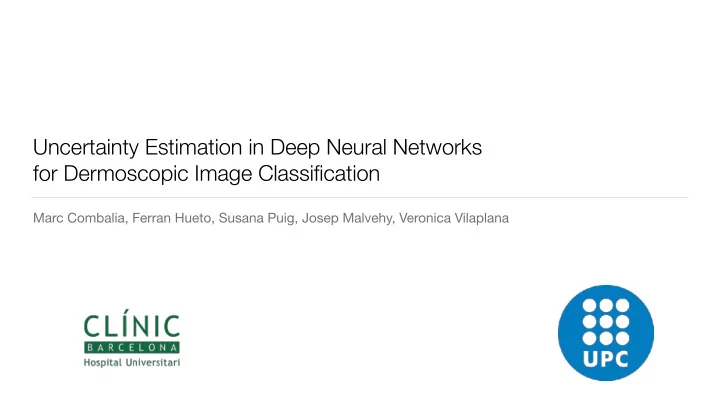

Uncertainty Estimation in Deep Neural Networks for Dermoscopic Image Classification Marc Combalia, Ferran Hueto, Susana Puig, Josep Malvehy, Veronica Vilaplana
Introduction
Neural Networks in HealthCare • High performance of AI in HealthCare • Real World Implementations are still scarce… • Why? One of the reasons… • Uncertainty : current neural networks produce point estimates, and don’t give any measure of confidence of the prediction.
Uncertainty • Epistemic Uncertainty • Epistemic uncertainty or model uncertainty captures the uncertainty in the model parameters. • Aleatoric Uncertainty • Aleatoric uncertainty is described by the noise in the observations; it is the input- dependent un- certainty.
Methods
Bayesian Neural Networks • Uncertainties are formalized as probability distributions over the model parameters (for epistemic uncertainty) or model inputs (for aleatoric uncertainty) • But how can we estimate the probability distributions? • MONTECARLO SAMPLING
Epistemic Uncertainty Estimation • MonteCarlo Dropout • When you want to estimate using MonteCarlo dropout, you sample using a “helper” distribution (generally bayesian / uniform…) • MonteCarlo Dropout can be seen as sampling the parameters of the NN with a Binomial Distribution.
Aleatoric Uncertainty Estimation • MonteCarlo Sampling.. but from capturing parameters • We already know that! Data Augmentation! • Sampling the data with a priori random distribution over capturing parameters (rotation, translation, color, …)
Uncertainty Aggretation Metrics • Prediction Entropy • Prediction Variance • Bhattacharyya Coefficient
Materials
ISIC Challenge 2018 • This dataset is composed of 10,015 dermoscopic images corresponding to 7,470 skin lesions. • Each image is paired with its corresponding label indicating the lesion diagnosis and other metadata surrounding the lesion and the patient. • The test dataset of the ISIC 2018 Challenge contains 1512 images that the participants are asked to classify in their submission file.
ISIC Challenge 2019 • The training dataset of the ISIC Challenge 2019 consists of 25331 dermoscopic images. • Eight diagnostic categories: melanoma, melanocytic nevus, basal cell carcinoma, actinic keratosis, benign keratosis, dermatofibroma, vascular lesion, and squamous cell carcinoma. • This dataset includes all the images from the HAM10000 dataset, and also adds images from the BCN20000 dataset and the MSK dataset. • The BCN20000 dataset is considered to be remarkably complex since it includes uncurated images from day to day clinical practice. • The test dataset from the ISIC Challenge 2019 consists of 8238 images and includes a set of images that are not contained in the diagnostic categories provided in the train- ing split (Unknown category)
Experiments
Base Architecture • Efficient-Net-B0 architecture. • Training Data Augmentation: rotations within a range of 180 degrees, resized crops with scales 0.4 to 0.6 and ratio of 0.9 to 1.1, color jitters including bright- ness (10%), saturation (10%), contrast (10%) and hue (3%), horizontal and vertical flips. • We use Adam optimization with a base learning rate of 0.001 and Cosine Annealing Warm Restarts • To account for the severe class imbalance present in the datasets, we use weighted sampling to construct a uniform class distribution in the training batches.
Experiment Set 1 Experiment Set 2 • We aim to determine if the proposed • We aim to determine if we can use uncertainty metrics can be related to the uncertainty metrics presented in errors in the prediction from the classifier. section 3 to detect out-of-distribution samples, that is, samples from • We train two classifiers for the problem of diagnostic categories that are not skin lesion classification in the ISIC present in the training set. Challenge 2018 and 2019 datasets, respectively • ISIC Challenge 2018: we move a subset of classes from the training set • During inference, we forward each image to the test set, train the network with T = 100 times through the neural the re- duced training set. network using Test Augmentation, Test Time Dropout, and both uncertainty tech- niques simultaneously • ISIC Challenge 2019 as is. •
Experiment Set 1
Results Experiment Set 1 (I)
Results Experiment Set 1(II)
Experiment Set 2
Results Experiment Set 2 - ISIC Challenge 2018
Results Experiment Set 2 - ISIC Challenge 2019
Conclusions • Uncertainty metics are predictive of sample error • Uncertainty metrics are predictive of out of distribution • Selecting a threshold for OOD is hard without exemplar samples
Recommend
More recommend